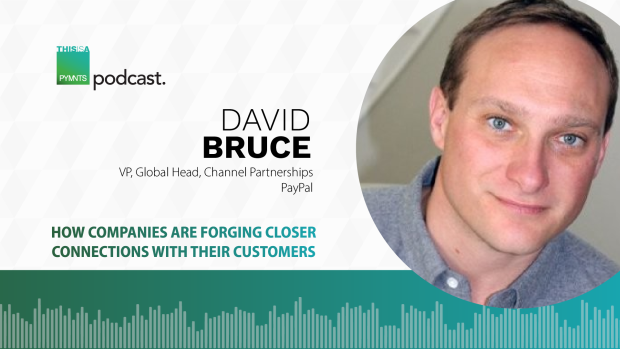Trust, Choice and Convenience Are the New Glue of Customer Loyalty

Customer acquisition costs aren’t less costly, and consumers have a universe of choices at their fingertips now. It’s time for businesses and consumers to get to know each other better because the ripcord methods of the pandemic must be refined, or defections will scale.
It’s crystal clear to David Bruce, vice president, Global Head, Channel Partnerships at PayPal.
“We are seeing this trend around [a business philosophy] called relationship commerce … and it’s aimed at kind of capitalizing [on] building better connection points with customers,” he told PYMNTS. “This isn’t a new phenomenon. This is about … how you continue to double down on customer loyalty in what is basically a new world order.”
With customers now more than two years into the digital shift, those early and even mid-pandemic digital moves to wow consumers and keep them spending are getting old — bordering on ancient as internet time flies — making engagement a true multi-company effort. Saying that a good on-ramp to relationship commerce is partnering with trusted brands and extensible networks, Bruce said to go for the gusto in teaming up with other brands.
“Bringing two brands together that are well known really … helps solidify [the trust consumers have for] both organizations,” he said.
Not only does it move the needle for operational efficiencies, but customers like it better.
“Instead of dealing with dozens of different third-party vendors, one for each commerce function, customers want to work with a single strategic partner” that offers quicker access to on-demand technology and tools — while providing expert advice around them.
Read: PayPal Combines COVID Learning With Digital Transformation to Pursue ‘Commerce 2.0’
Choose It or Lose It
Mirroring study results PYMNTS sees in our extensive research into interconnected elements of consumer loyalty is the fact that every digital brand is instantly replaceable. That’s a red alert.
“We’ve got data that shows if a merchant doesn’t have the consumer’s preferred payment method, they just literally won’t shop with them, let alone check out,” Bruce said.
Calling payments choice “a mantra at PayPal,” he said, “it helps equate to a greater likelihood of conversions, both online and in-store. It also, again, brings you back to having a deeper connection with your customer because you are enabling the services that they want to see as part of the ecosystem.”
Right alongside choice, and possibly a bit more potent, is trust. Fail at gaining and nurturing trust as a merchant or brand and that’s a recipe for higher costs — and bolting customers.
“Trust creates loyalty,” Bruce told PYMNTS. “We are proud as a company to be in a certain group of corporate entities, whether it’s in payments or not, that have that halo effect of trust.”
But what if you’re not, say, PayPal and haven’t yet earned or solidified that halo of trust?
He went right back to choice — a virtuous circle — adding that “it doesn’t have to just be PayPal. In fact, we advocate that you should have a range of payment methods so that you can cater to the differences in the way consumers buy. Choice and trust come together … to make sure consumers are getting access to what they need.”
With payments choice as the start of trust creation, he said businesses and channel partners across categories and verticals are integrating PayPal and Venmo in novel ways and bringing in new forms like the buy-now-pay-later service.
“That’s happening across a number of different categories,” he said. “You have to really think about the category and the consumers within it and how they’re buying.”
See also: PayPal, Venmo Now Payment Options at In-Store POS
Don’t Go It Alone
As new payment options glimmer on the horizon, some real throwbacks were revivified by the pandemic and now are part of an expected payment experience, even if not used.
Examining the phenomenon of the restaurant sector and its embrace of QR codes as “touchless” and “contactless” entered the everyday lexicon, Bruce sees lessons for others.
“It’s interesting to think that restaurants are probably the best use case in … how to use QR codes in a successful way. There’s actually a lot of other industries looking at how the restaurant environment adapts to those types of payment methods and makes some of those decisions,” he said.
Strange to say, there’s a beauty to the QR code, but there is. “As soon as you hit the QR code, you go into a mobile web flow,” Bruce said. That catapults the transaction into the digital domain, where it can be used to fortify relationship commerce at the consumer level.
How that works out is a function of tying payments experience to customer experience.
It’s a lot to take in despite two-plus years of intense innovation and investment, and few companies have the wherewithal to go it alone into real relationship commerce.
“Our view is that we’re in this new world order about being open, collaborative, innovative, and basically making sure that you are partnering across the ecosystem … to enable choice,” he said.
As PayPal sees no slowing of digital payments regardless of devices or physical settings, it goes back to picking the right partners and minimizing friction — even if you’re PayPal.
“One core tenet is that no one company can do all of this. PayPal can’t do all of this,” he said.
“Partnerships across the ecosystem that are focused on making the customer successful, that’s really where I think the market’s moving. You need to be open; you need to be honest and transparent. That may include competing in some areas, as well as entering new areas.”
